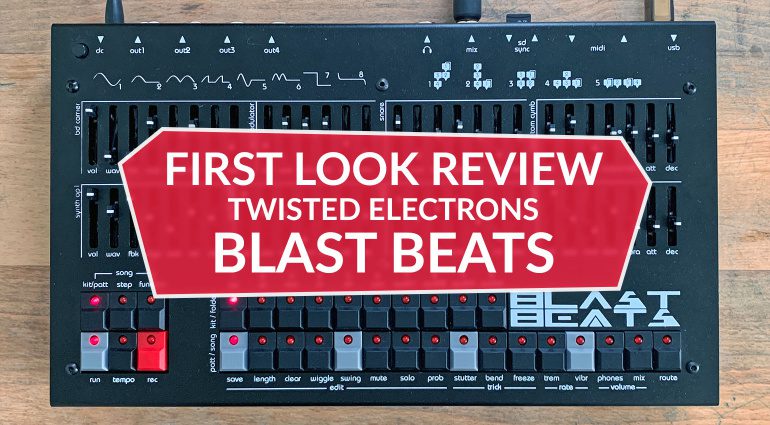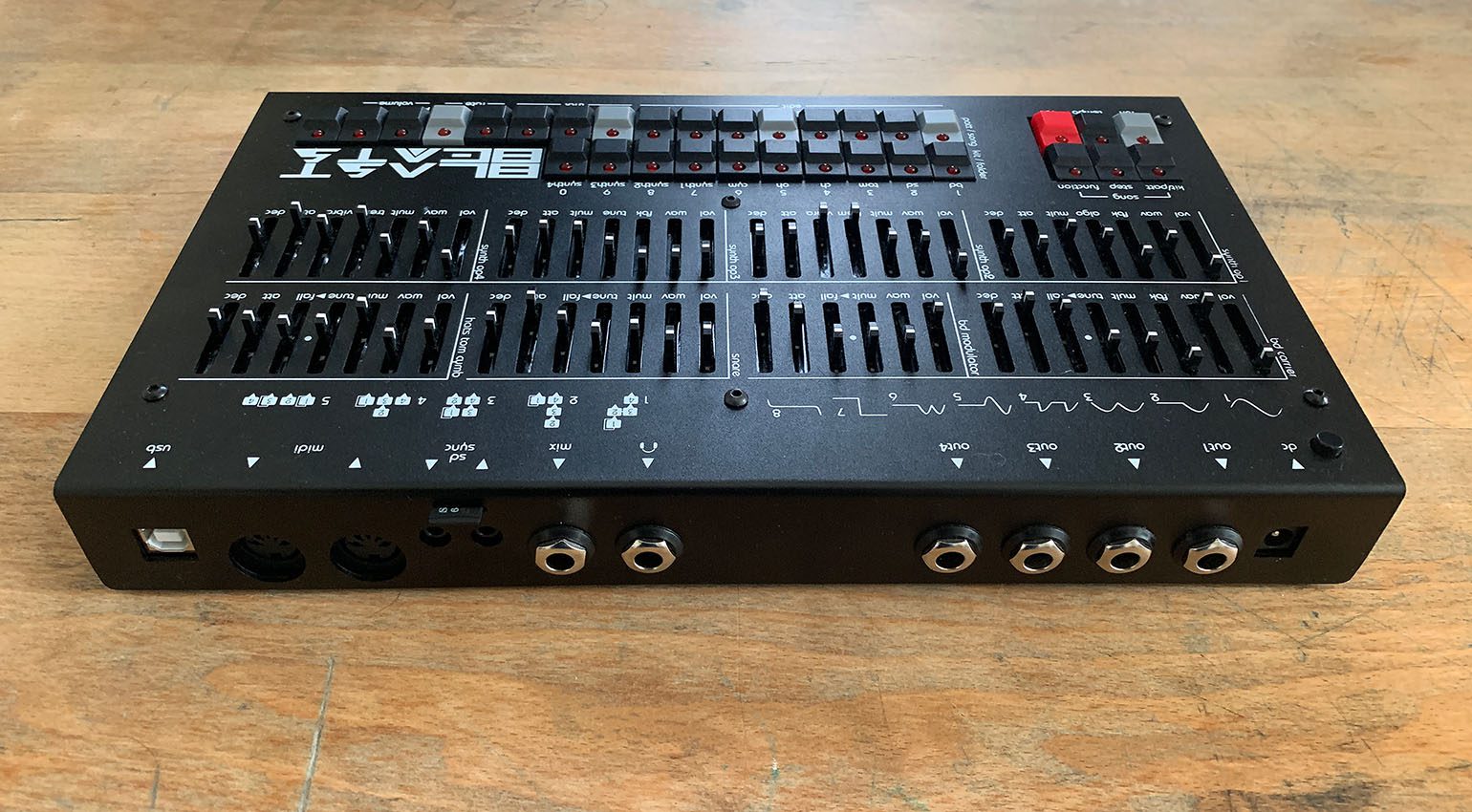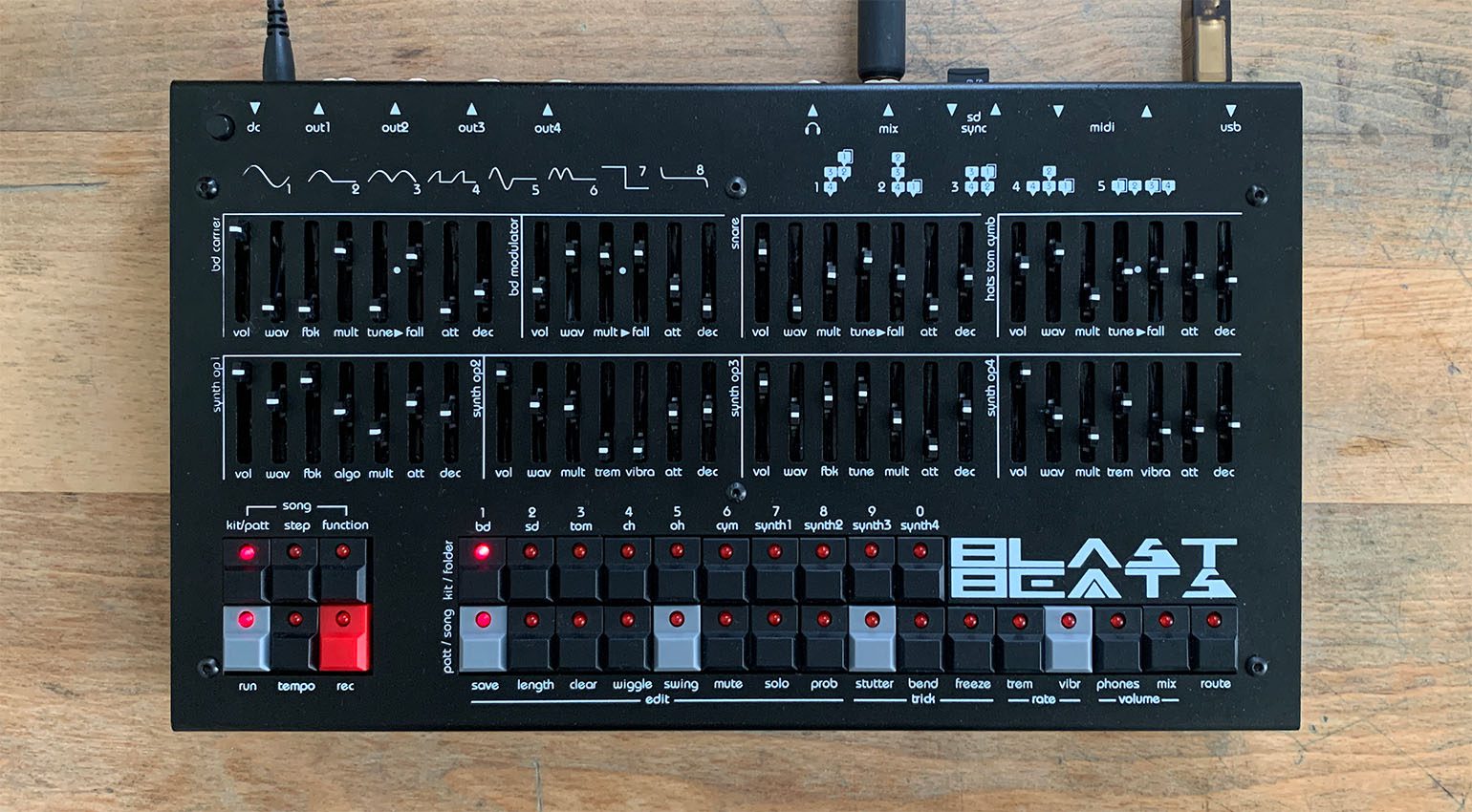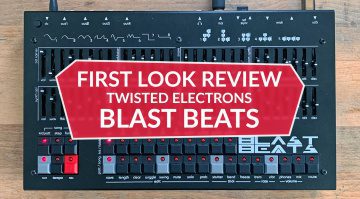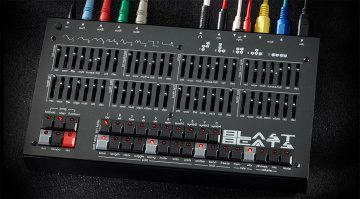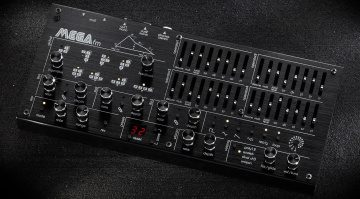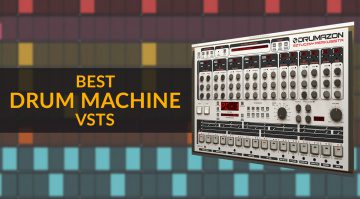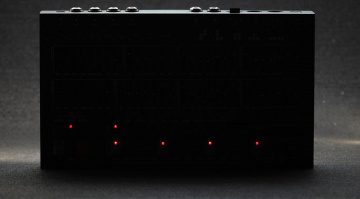First Look Review: Twisted Electrons Blast Beats
FM groove box with Sound Blaster chip
The sound of DOS game soundtracks warms your heart and makes you feel nostalgic? The new Twisted Electrons Blast Beats might be just what you need! The drum machine and synth is built around the Yamaha YMF262/OPL3 FM chip, which is the same chip that brought games to life on the Sound Blaster Pro 2 and Sound Blaster 16 cards back in the day. We had the opportunity to put a prototype through its paces.
Twisted Electrons Blast Beats: The Sound Blaster is back!
Twisted Electrons specializes in building quirky groove machines from the sound chips of yesterday’s gaming consoles and computers. The French manufacturer has already turned the YM2612 sound generator of the SEGA MegaDrive/Genesis – another variety of Yamaha’s widespread FM chips – into the MEGAfm, a fabulous synth with plenty of hands-on control. The same goes for the Nintendo NES (hapiNES L) and of course the legendary SID chip of the C64 (TherapSid MKII / TherapKid). Following in those devices’ footsteps, Blast Beats is a drum machine and groove box dedicated to the FM sound of the Sound Blaster cards.
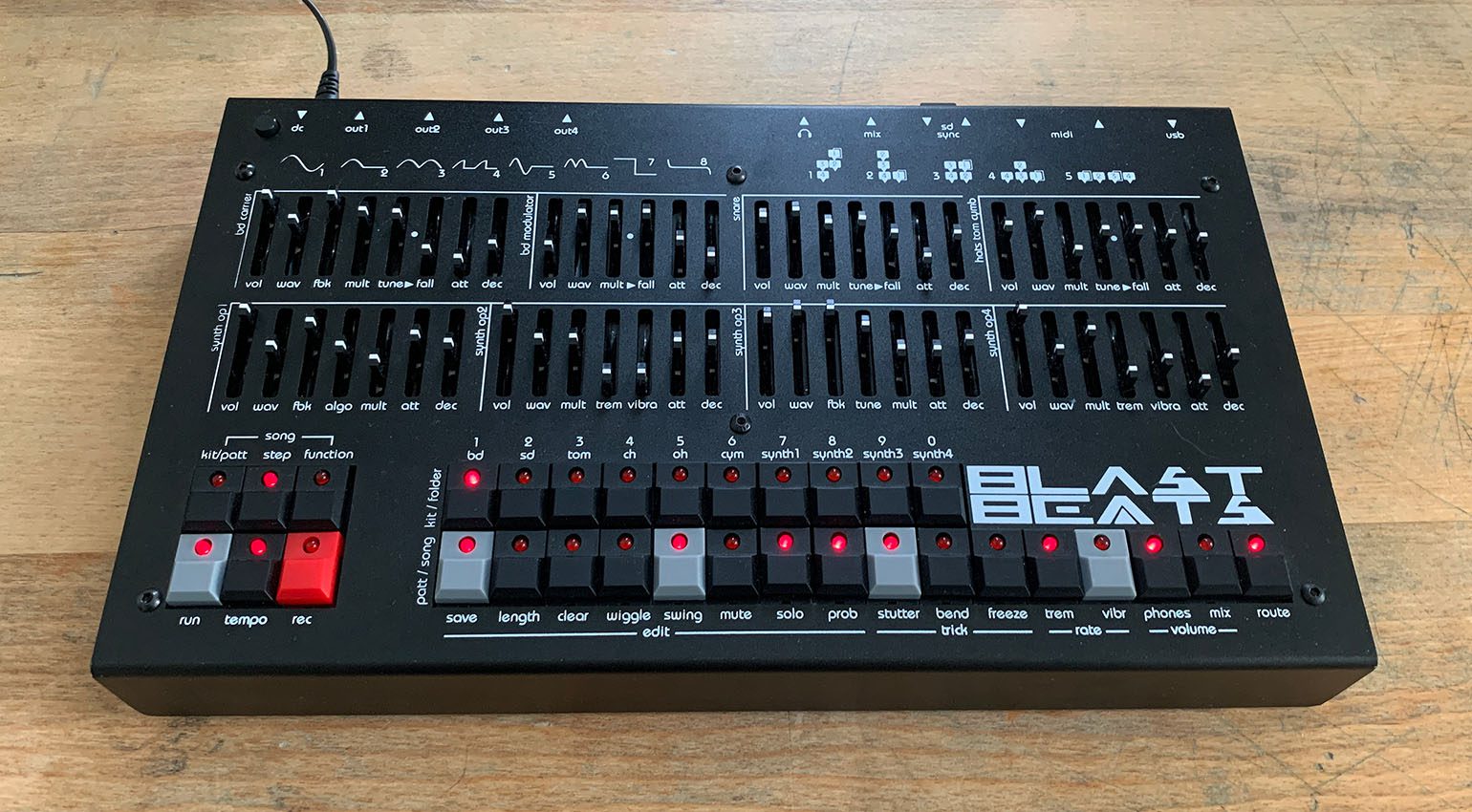
The Twisted Electrons Blast Beats is built around the Yamaha OPL3/YMF262 chip of the Sound Blaster cards · Source: Gearnews
I was never an avid gamer, but I did own a PC with a Sound Blaster 16 card back in the day and played a few games here and there. Quite honestly, the sound of those games is probably the part that I miss the least. But I always enjoy synths and drum machines that venture off the beaten path, and I can see that this type of retro FM sound generation could bring a very welcome breath of fresh air into any modern electronic producer’s sound arsenal. Especially since Twisted Electrons has gone to great lengths to make the inner workings of the YMF262 as accessible and tweakable as possible.
Just like the MEGAfm, Blast Beats promises intuitive access to the FM guts of the chip. With no less than 56 faders, all of which can be sequenced, you get plenty of real-time control over the parameters of the six drum voices and four synth parts. The synth is paired with a 64-step sequencer with real-time and step programming modes, a couple of probability and randomization features, and a bunch of nifty performance effects called Tricks.
Six drum voices and four synth parts
Blast Beats offers a total of ten instruments. The six drum voices (bass drum, snare drum, tom, closed and open hi-hat, cymbal) are joined by four synth parts, which consist of two or four FM operators depending on the selected algorithm. Two of these (Synth 1 and 2) are monophonic, while Synth 3 and 4 deliver duophonic sounds in two different configurations (more on this later).
Via two stereo DA converters, the ten sounds can be routed to the synth’s four individual outputs. Due to hardware limitations of the YMF262, the snare and hi-hats always end up on the same output, as do the tom and cymbal, but other than that, you’re free to choose.
Next to the individual outputs, you’ll find a headphone jack and a mono mix output, analog sync in/out jacks (1/8”) and MIDI in/out. There’s also a USB port for firmware updates (not for MIDI!) and a microSD card slot for storage.
Overview
The top row of faders is reserved for the drum sounds: two sets of faders for the bass drum carrier and modulator, one set for the snare, and one set for the hats, tom, and cymbal, which share their controls. The four blocks in the bottom row correspond to the four operators of the synth voices. There’s a choice of five algorithms, which are printed on the panel and selected using a slider in the OP1 section. Each section also has a slider that lets you choose from eight waveforms, which hints at a sonic potential that extends well beyond pure sine wave FM.
In step mode, the upper row of buttons is used to select the desired instrument for editing in the sequencer. In Kit/Patt mode, these buttons let you switch kits, i.e. complete sound sets consisting of six drum sounds and four synth sounds.
The bottom row consists of 16 X0X-style step buttons, which are also used to change patterns in Kit/Patt mode. In Function mode, they provide access to various other settings such as pattern length, clear, swing, mute, solo and the performance effects (“Tricks”) stutter, bend and freeze.
Structure
Blast Beats distinguishes between songs, patterns and kits. A song is a complete configuration of the machine that can be stored on and loaded from the SD card. You can save up to 160 songs per card.
Each song consists of up to 16 patterns and can also include a pattern chain with a maximum of 256 changes. In addition to this, each song contains up to ten kits. These are complete sound sets in which the positions of all sliders are stored. Kits can be linked to patterns, so that when the pattern changes, the sounds also change.
Sequencer
Each patterns comprises up to 64 steps; any arbitrary length is possible. Adjusting the pattern length is very quick and straightforward. You simply select the number of 16-step pages (1-4) using the upper row of buttons and then press the desired last step in the lower row. There’s also a fantastic shortcut for copying the first 16 steps to the following pages by holding down the first button of the upper row while pressing buttons 2-4 as desired. This allows you to extend and modify patterns in an instant.
The sequencer offers two main modes of operation: Kit/Patt and Step. Kit/Patt mode is great for jamming and performing with patterns and kits. In this mode, you change patterns using the lower row of buttons and kits in the upper row. Each of the 16 patterns can have one of the ten kits assigned to it. Copying patterns and kits is very quick and easy.
Hit Record while the sequencer is running in Kit/Patt mode and you’re recording a pattern chain. Deleting these chains is also very easy to do on the fly, which makes them a great performance feature.
In Step mode, Blast Beats operates in the traditional X0X style. The ten buttons of the upper row correspond to the ten instruments, the lower row sets the steps. Pressing REC while the sequencer is running activates the real-time recording mode, in which you can punch in the six drum sounds using the corresponding buttons, or play the synth sounds via the bottom row, which doubles as a keyboard in this mode.
Fader Automation
In Step mode, Blast Beats can also record all fader movements, which of course opens up enormous possibilities given the large number of sliders. As soon as you move a fader while the sequencer is running and the REC button is active, its movement is recorded in the pattern. To delete fader automations, you have to switch to Function mode, but that’s also very quick and easy to do.
Since we’re talking about FM synthesis, even the slightest fader movements can result in drastic changes to the sound. With some clever programming, Blast Beats can pump out patterns that sound like they contain way more than just the ten sounds of the kit.
Even more movement: Probability, Wiggle and Tricks
For even more variations, Blast Beats offers a couple of neat randomization features. Prob allows you to set the step probability per channel, meaning the chance that a programmed step is triggered on each pass of the sequencer. Wiggle is a random movement generator that continuously “wiggles” the faders assigned to it within an adjustable range. Both are awesome ways to inject life into static patterns.
Function mode also includes three performance effects that Twisted Electrons calls Tricks. Stutter is a retrigger effect where you can set the subdivisions using the buttons of the top row. Bend pitches down the global tuning of the FM chip, resulting in a kind of spindown effect. Freeze “interrupts the communication between brain and voice”, as Twisted Electrons puts it, which leads to various glitches and unexpected effects. All three tricks can be automated and recorded in the sequencer.
And how does it sound?
From its Sound Blaster heart, Blast Beats pours a wide variety of unconventional drum and synth sounds that immediately struck me as a very charming addition to the standard electronic sound palette. For the most part, the sounds cannot hide the fact that they hail from an inexpensive synth-on-a-chip that wasn’t particularly hi-fi even when it came out, but that’s the whole point. While Blast Beats won’t win any awards for “warmth” or “punch”, it does have a distinct personality and it can sound surprisingly fat at times. It can certainly do much more than what’s commonly known as “chiptune music”.
With two independent sets of sliders for the carrier and modulator components, the bass drum offers the deepest controls and thus the widest sonic palette. The other drum sounds offer fewer settings, but even here Blast Beats delivers plenty of sonic potential thanks to the choice of eight waveforms.
When it comes to the four synth parts, you should keep in mind that they’re not all created equal. Synth 1 and 2 are monophonic, while Synth 3 and Synth 4 provide duophonic sounds. And the way in which the two voices operate differs between Synth 3 and 4: Synth 3 alternates between its two voices on each triggered step, allowing them to overlap. Synth 4 triggers both voices simultaneously and you can detune them, which makes this synth part the best choice for fat basses or stabs. If you take this into account and reserve Synth 4 for the bass (or whichever part you want to sound the fattest) and Synth 3 for pad-like sounds, for example, you can make the most of the limited polyphony of the synth parts.
One last thing: Don’t expect to turn on Blast Beats and immediately be greeted by a perfectly polished and mixed beat that sounds just like your favorite DOS game. It does take some time to find the sonic sweet spots of the machine, especially with this amount of tweakability. But once you get the hang of it, Blast Beats can provide sounds that stand out very pleasantly from the crowd and can add a unique twist to any track or live set.
Price and availability
Twisted Electrons Blast Beats is now available:

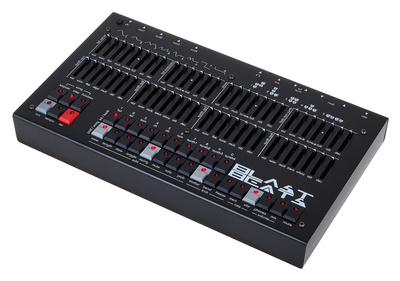
More info about Twisted Electrons Blast Beats
Videos
You are currently viewing a placeholder content from YouTube. To access the actual content, click the button below. Please note that doing so will share data with third-party providers.
You are currently viewing a placeholder content from YouTube. To access the actual content, click the button below. Please note that doing so will share data with third-party providers.

 5,0 / 5,0 |
5,0 / 5,0 | 